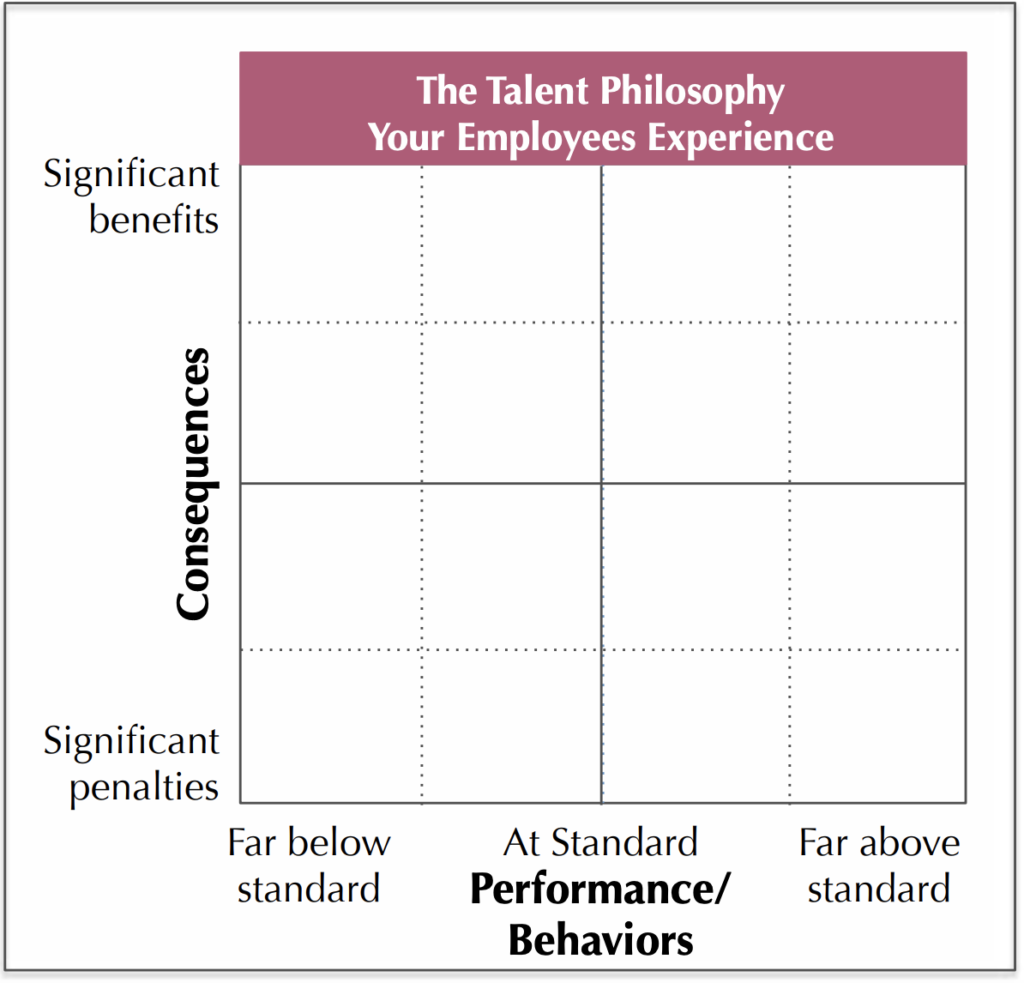Please enter your email in order to download this publication.
Your company’s talent philosophy captures your “rules of the road” for managing talent. Map your curves to see if the talent philosophy you state is the philosophy that your employees experience.
By Marc Effron, President, Talent Strategy Group
Whether explicit or implicit, every company has a talent philosophy – their “rules of the road” for managing talent. When it’s explicit, the philosophy tells managers and employees how to succeed in your organization.
When it’s implicit, your managers and employees still hear messages about how to succeed but perhaps not the messages you had intended. Instead, they’ll observe how talent-related decisions are made and infer the real rules for winning at your company.
The two most powerful elements in a company’s talent philosophy are its views on managing performance and behaviors. You can quickly assess what messages your company sends in these areas by graphing its performance and behavior curves.
Mapping Your Curves
In an ideal world, individual performance would be perfectly correlated with individual rewards. As the former increased, so would the latter.
The same would apply to leadership behaviors. Better behaviors would yield benefits and worse behaviors would incur penalties. If we graphed that perfect relationship it would look like Graph 1.

Unfortunately, the relationship between performance, behavior, and consequences isn’t that linear in most companies. That’s often when an organization’s stated talent philosophy is trumped by the philosophy that employees actually experience.
You can understand your company’s implicit talent philosophy and its implications by graphing the answer to these two core talent philosophy questions:
1) At what thresholds (high and low) do consequences start for higher or lower performance?
2) How severe (positive or negative) are those consequences?
For example, if you work in a company that somewhat rewards high performance but tolerates relatively weak performance, your company’s graph might look like Graph 2.

If you work in a company where positive behaviors don’t benefit employees but negative behaviors are not tolerated, your company’s graph might look like Graph 3.

Assess Your Organization
Draw a line on the graph below that reflects the answers to these questions at your company. Draw one line to map performance and one to map behaviors.

Any variance in your curve from the perfect relationship shown in Graph 1 suggests a less than ideal relationship between what one does and what one gets. It might be tenure, not disturbing the status quo, etc., but your promises about performance and behaviors having consequences may ring rather hollow.
Map Your Gaps
Once you’re drawn the graphs that show how your employees actually experience your talent philosophy, use the same graphs to draw your company’s stated talent philosophy. Now, shade in the area between the two lines (see Graph 4).

The shaded areas are talent philosophy gaps and show the disconnection between corporate dreams and employee reality. The larger the gaps, the more likely employees are to have heightened cynicism and decreased engagement.
Close the Gaps
To more closely align your actual philosophy and your stated one, answer these questions:
1) Do you understand why this gap exists? If you don’t understand the gaps, do you have an engagement survey or similar data that could provide insights?
If not, can you hold employee focus groups to understand their thoughts on the disconnection?
2) What are the three largest levers for closing that gap? Do you need more consistent support from your senior team to enforce the philosophy? If so, how can you secure that?
Do you need to redesign your performance management process to better differentiate?
Do you need to put more “teeth” into how you measure and hold leaders accountable for behaviors?
Identify the three most powerful actions you could take to align your company’s desired and actual talent philosophy.
3) What can you achieve this month? Next month? Don’t get overwhelmed by the size of the challenge. Your company’s actual talent philosophy took years to form.
You’re not going to realign it this week. Instead, identify one specific action you can take this month to move your action plan forward. Do the same for next month and the month after.
Incremental progress is still progress and you’re far more likely to achieve (and feel good about) a series of small wins than an unfinished grand solution
Start Now
A company’s talent philosophy is the foundation on which all other talent practices rest. You can ensure a stable foundation by making sure that your company’s statements about its philosophy align with reality.
Map your curves, identify your gaps, and create a realistic plan that includes short-term wins. You’ll quickly decrease the talent philosophy gaps and increase your employees’ confidence that your company means what it says.
More About The Author:
- Marc Effron, President, Talent Strategy Group
- Marc founded and leads The Talent Strategy Group and consults globally to the world’s largest and most successful corporations. He co-founded the Talent Management Institute and created and publishes TalentQ magazine. He co-authored the Harvard Business Review Publishing best-seller One Page Talent Management and 8 Steps to High Performance.

